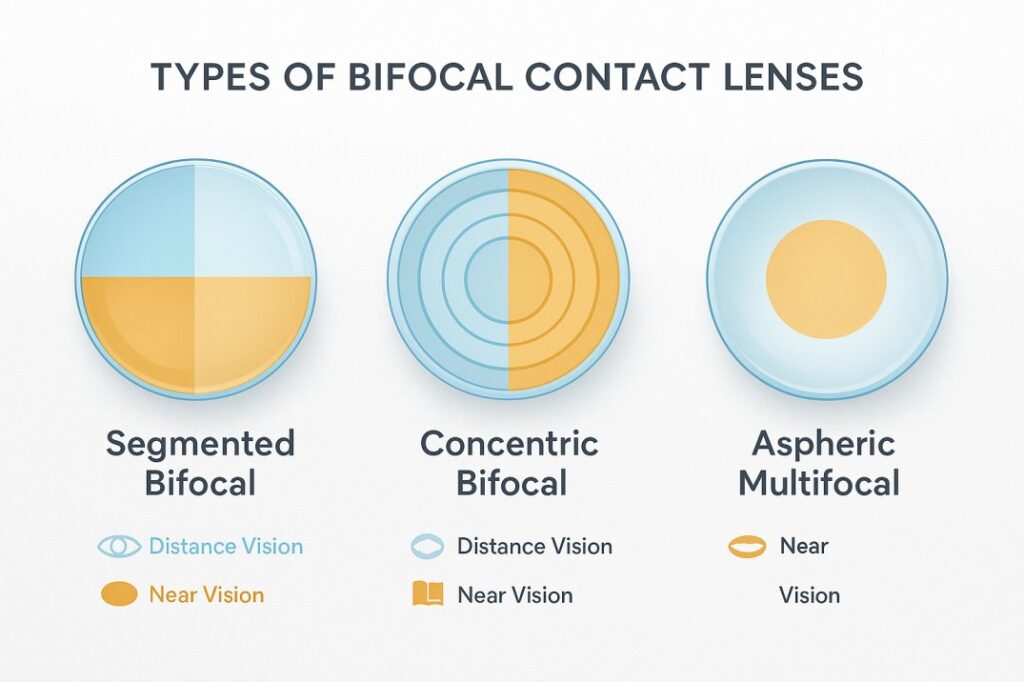2025 Guide to Bifocal Contact Lenses
Are you squinting at your phone screen more often lately? Finding yourself holding restaurant menus at arm’s length? If you’re in your 40s or beyond, you’re experiencing presbyopia—a natural aging process that affects nearly everyone. The good news? Bifocal contacts combine up-close and distance vision prescriptions into a single lens, allowing you to see both near and far without glasses.
At Cannon EyeCare in Seattle’s University Village, we’ve helped hundreds of patients transition from the frustration of constantly switching between reading glasses and distance vision to the freedom of bifocal contacts. Our comprehensive approach combines Midwestern hospitality with cutting-edge eye care technology, ensuring you get the personalized attention you deserve during this important vision transition.
Understanding Bifocal Contacts: The 2025 Perspective
Bifocal contact lenses are lenses that offer two different prescriptions in a single lens. One prescription is for close reading, and the other for normal, distance vision. Think of them as progressive glasses in contact lens form—but with some key differences in how they work.
What Makes 2025 Different?
The bifocal contact landscape has evolved dramatically. Today’s multifocal contact lenses are a more convenient and comfortable alternative to bulky bifocals and reading glasses, with advanced technologies like Precision-Profile® design and SmartShield® Technology. Modern materials and manufacturing techniques have addressed many of the comfort and vision quality issues that plagued earlier generations of these lenses.
Who Needs Bifocal Contacts?
Presbyopia usually begins by the age of 40 to 45, with the amplitude of accommodation reducing from approximately 14 diopters at ten years of age to 0.5-1 diopter by age 60. The prevalence of presbyopia in the United States ranges from 83.0% to 88.9% for adults aged 45 years and older. If you’re experiencing any of these symptoms, bifocal contacts might be the solution:
- Difficulty reading small print on your phone or computer
- Holding books or menus farther away to see clearly
- Eye strain during close-up work
- Frequent headaches from squinting
- Already wearing contacts for distance vision, but struggling with near tasks.s
How Bifocal Contacts Work: Technology Explained
Understanding how bifocal contacts function helps set realistic expectations for your experience. Multifocal contacts work with the natural function of your pupils. The pupils of your eyes dilate slightly as you look at distant objects, and they constrict when you read or look at something close-up.
The Science Behind Clear Vision
Unlike bifocal glass,, es where you physically move your head to look through different zones, bifocal contacts move with your eye. Similar to multifocal eyeglass lenses, multifocal contacts are divided into different zones of vision: a zone for up close, a zone for intermediate vision, and a zone for distance.
Your brain learns to automatically select the appropriate zone based on what you’re trying to see. This process, called neuroadaptation, typically takes 2-4 weeks but can vary significantly between individuals.
Modern Technology Advances
Recent studies have shown significant improvements in bifocal contact design. High contrast visual acuity has improved compared to earlier studies, while advanced diagnostic techniques allow for better contact lens applications. Features like moisture-locking technology and UV protection have become standard in premium lenses.
Types of Bifocal Contacts: Finding Your Perfect Match
Not all bifocal contacts are created equal. Understanding the different types helps you and your eye care provider at Cannon EyeCare choose the best option for your lifestyle and visual needs.
Segmented Bifocal Contacts
Segmented bifocal contacts (also referred to as alternating or translating bifocals) mimic bifocal eyeglasses closely, with a separate section for each prescription. Usually, the near vision prescription is in the lower part of the lens, and the normal, distance prescription is in the rest of the lens.
Best for:
- People transitioning from bifocal glasses
- Those who prefer distinct visual zones
- Patients with larger pupils
Concentric Design Bifocal Contacts
The center of the lens has the normal vision prescription, and the surrounding ring has the near vision prescription. This is called a concentric or simultaneous bifocal.
Best for:
- First-time bifocal contact wearers
- An active lifestyle requires stable vision
- Those who want a more natural transition between distances
Aspheric Multifocal Contacts
Aspheric multifocal contact lenses work similarly to progressive lenses, with one prescription strength at the center and a gradual transition in power as you move across the lens.
Best for:
- Computer users needing intermediate vision
- People want the smoothest transition between distances
- Those with demanding visual requirements
Bifocal vs Multifocal Contacts: Making the Right Choice
The terminology can be confusing, so let’s clarify the key differences:
Bifocal Contacts:
- Provide two different prescriptions in the same lens, correcting vision at near and distance
- Have distinct zones for each prescription
- More similar to traditional bifocal glasses
Multifocal Contacts:
- Have multiple powers in each lens, helping people focus on objects at more than two distances.
- Include intermediate vision correction
- Provide gradual transitions between power zones
“Multifocal contacts” is an umbrella term that includes any contact lenses with more than one lens strength. Bifocal contacts would fall into this category.
Which Should You Choose?
The decision depends on your specific visual needs:
- Choose bifocal contacts if you primarily need help with reading and have good intermediate vision
- Choose multifocal contacts if you spend significant time on computers or need clear intermediate vision
- Consider your lifestyle: Active individuals often prefer the stability of concentric designs
The Fitting Process at Cannon EyeCare
Our approach to bifocal contact fitting reflects our commitment to thorough excellence and personalized care. Here’s what you can expect during your appointment at our University Village or Pike Place Market locations:
Comprehensive Eye Examination
We begin with a detailed assessment that goes beyond basic vision testing:
- Pupil size measurement in different lighting conditions
- Accommodation amplitude testing to determine your presbyopia progression
- Corneal topography to ensure proper lens fit
- Tear film evaluation for contact lens compatibility
- Lifestyle assessment to understand your visual demands
Trial Lens Fitting
The trial period of the lenses must be extended and realistic, and should be based on patient feedback. The trial lens power must be close to the required power. We typically provide several trial options, allowing you to experience different designs in real-world situations.
Follow-Up Care
Our Midwestern approach means we don’t rush the process. Expect multiple follow-up appointments during your first month to ensure optimal comfort and vision. We monitor your adaptation progress and make adjustments as needed.
Cost Analysis: Investment in Clear Vision
Understanding the financial investment helps you make an informed decision. The national average cost for multifocal contacts is $279 per year, but costs can range significantly based on your specific needs and lens type.
Breaking Down the Costs
Initial Fitting Fees:
- Comprehensive eye exam: $120-$250 (average in Seattle)
- Contact lens fitting: $100-$200 (additional)
- Spherical (basic): $100 at Cannon EyeCare
- Toric (for astigmatism): $150-$200
- Bifocal/Multifocal: $150-$200
- Trial lenses: Often included in the fitting fee
Ongoing Lens Costs:
- Daily disposable bifocals: $50-$150 per month
- Monthly bifocal lenses: $25-$80 per month
- Annual costs: The national average cost of bifocal contacts is $279 per year for multifocals, but can range from $216 to $548, depending on type and prescription
Additional Expenses:
- Contact lens solutions (for monthly lenses): $100-$200 annually
- Regular check-ups: $100-$150 per visit
Insurance Coverage
Most vision insurance plans provide some coverage for contact lenses. At Cannon EyeCare, we accept major insurance plans including Premera, Regence, and Kaiser PPO, but do not participate in VSP, Davis, or EyeMed due to contractual limitations. Our staff can help verify your benefits and maximize your coverage.
Value Considerations
While bifocal contacts cost more than single-vision lenses, consider the alternative costs:
- Multiple pairs of glasses (reading, computer, distance)
- Progressive lenses (often $300-$800)
- The inconvenience and lifestyle limitations of constantly switching glasses
Top Bifocal Contact Brands for 2025
Based on current market analysis and patient satisfaction data, here are the leading bifocal contact options available:
Daily Disposable Options
1. Dailies Total1 Multifocal (Alcon)
- Features Water Gradient Technology, creating a cushion of moisture, and SmarTears® Technology for an ultra-thin protective layer
- Best for: First-time wearers, dry eye sufferers
- 90 lenses per box (3-month supply)
2. 1-Day Acuvue Moist Multifocal (Johnson & Johnson)
- LACREON® Technology ensures a comfortable wearing experience with Class 2 UV protection
- Best for: UV protection needs, active lifestyles
- Available in 30 and 90 lens boxes
Monthly Options
3. Biofinity Multifocal (CooperVision)
- Aquaform® Technology locks in water with Balanced Progressive® Technology, providing several correction zones tailored to your prescription
- Best for: Extended wear comfort, natural vision transitions
- 6 lenses per box (6-month supply)
4. Air Optix Aqua Multifocal (Alcon)
- Precision-Profile® design works with the eyes’ natural function with SmartShield® Technology, creating a protective layer against deposits
- Best for: Clear vision, deposit resistance
- 6 lenses per box (6-month supply)
5. Bausch + Lomb Ultra for Presbyopia
- 3-Zone Progressive™ Design delivers outstanding near, intermediate, and distance vision with MoistureSeal® Technology
- Best for: Digital device users, all-day comfort
- 6 lenses per box (6-month supply)
Specialty Options
For Astigmatism: Bifocal contacts for astigmatism usually provide excellent functional vision for most daily activities. Options include Bausch + Lomb Ultra Multifocal for Astigmatism and specialty toric multifocal designs.
Living with Bifocal Contacts: Real Patient Experiences
Understanding what to expect helps set realistic expectations for your bifocal contact journey.
The Adjustment Period
Just like with any new prescription, your eyes will need time to adjust to wearing your multifocal contacts. After a while, you’ll view distant and near objects clearly by looking through the appropriate zone of the lens without having to give it a single thought.
Weeks 1-2: Initial Adaptation
- Some visual confusion as your brain learns the new system
- Possible mild headaches or eye strain
- Depth perception may feel different
Week 3-4: Neuroadaptation
- Vision becomes more natural and automatic
- Reduced awareness of lens zones
- Improved confidence in daily activities
Month 2+: Full Adaptation
- Seamless vision transitions
- Natural eye movements and focus changes
- Most patients report high satisfaction
Success Stories from Cannon EyeCare Patients
Sarah, 45, Marketing Professional: “I was dreading the thought of reading glasses, but Dr. Cannon fitted me with daily multifocal contacts that changed everything. I can read my phone, work on my computer, and drive without any issues. The first week was a bit weird, but now I don’t even think about it.”
Michael, 52, Architect: “As someone who needs to see fine details at different distances all day, bifocal contacts have been a game-changer. The fitting process at Cannon EyeCare was thorough, and they took time to find the right lens for my needs.”
Common Challenges and Solutions
Challenge: Glare and Halos Some people experience glare, halos, or difficulty seeing in low-light conditions. Solution: Usually improves with adaptation; consider different lens designs if persistent.
Challenge: Reduced Distance Sharpness. Distance vision isn’t quite as sharp as with contact lenses designed for distance-only vision. Solution: Proper lens selection and realistic expectations; some patients benefit from monovision alternatives.
Challenge: Digital Eye Strain Modern life demands extensive screen time, which can be challenging with bifocal contacts. Solution: Computer-specific lens designs, blue light filtering, and proper workstation ergonomics.
Scientific Evidence Supporting Bifocal Contacts
Recent research provides strong evidence for the effectiveness of presbyopia-correcting contact lenses:
Clinical Study Findings
A systematic review found high-quality scientific evidence supporting the use of presbyopia-correcting contact lenses, with several randomized controlled clinical trials conducted. Key findings include:
- Visual Performance: Modern multifocal designs provide satisfactory visual acuity for most daily activities
- Patient Satisfaction: Studies show that patients above 40 are seeking suggestions and recommendations from eye care practitioners for upgrading contact lenses
- Adaptation Success: Most patients successfully adapt to multifocal vision systems within 4-6 weeks
2025 Technology Advances
The 2024 Continued Learning Evidence-based Academic Reports (CLEAR™) expanded on previous research, collating current evidence on presbyopia management. Recent innovations include:
- Improved lens materials with better oxygen permeability
- Advanced surface treatments for deposit resistance
- Optimized optic zone designs for different pupil sizes
- Enhanced manufacturing precision for consistent quality
Dropout Prevention Strategies
Roughly half of contact lens wearers drop out by age 50, but advanced, easy-to-fit multifocal lens technologies mean patients don’t need to compromise. Successful fitting strategies include:
- Extended trial periods with multiple lens options
- Comprehensive lifestyle assessment during fitting
- Regular follow-up care during the adaptation period
- Patient education about realistic expectations
Alternative Options to Consider
While bifocal contacts work well for many patients, they’re not the only solution for presbyopia:
Monovision Contact Lenses
Monovision is an alternative to bifocal contact lenses for the correction of presbyopia, where one eye is corrected for distance and the other for near vision.
Pros:
- Less expensive than bifocal contacts
- Clearer vision at each corrected distance
- Faster adaptation for some patients
Cons:
- Reduced depth perception
- Compromise in binocular vision
- Not suitable for all lifestyles
Progressive Glasses
Traditional progressive glasses remain a popular choice, offering:
- Excellent visual quality at all distances
- No adaptation period for near/far zones
- More cost-effective for occasional wear
Surgical Options
For patients seeking permanent solutions:
- LASIK with monovision: Corrects one eye for distance, one for near
- Presbyopia-correcting IOLs: During cataract surgery
- Corneal inlays: Small implants to improve near vision
Expert Tips for Bifocal Contact Success
Based on our experience at Cannon EyeCare, here are professional recommendations for maximizing your bifocal contact success:
Before You Start
- Schedule a comprehensive evaluation that includes a lifestyle assessment
- Discuss your visual demands honestly with your eye care provider
- Plan for the adaptation period in your schedule
- Have realistic expectations about the adjustment process
During Adaptation
- Wear lenses consistently rather than part-time during the first month
- Practice specific tasks like reading and computer work in controlled environments
- Keep a vision diary, noting challenges and improvements
- Stay in close contact with your eye care provider
Long-term Success
- Maintain regular check-ups to monitor lens performance and eye health
- Replace lenses as scheduled to ensure optimal vision and comfort
- Update prescriptions as presbyopia progresses
- Communicate changes in vision or comfort immediately
Why Choose Cannon EyeCare for Your Bifocal Contact Fitting
Our approach to bifocal contact fittings reflects our core values of thorough excellence and personal connection:
Expertise You Can Trust
- Specialized training in presbyopia-correcting contact lenses
- State-of-the-art diagnostic equipment for precise fittings
- Extensive experience with diverse patient populations
- Ongoing education in the latest contact lens technologies
Personalized Care
- Unhurried appointments that allow thorough evaluation
- Multiple trial options to find your perfect lens
- Extended follow-up care during the adaptation period
- Lifestyle-focused recommendations based on your needs
Convenient Locations
- University Village: Easy parking and shopping center convenience
- Pike Place Market: Historic downtown location with public transit access
- Insurance accepted: We work with major Seattle-area vision plans
Community Commitment
As part of the Seattle community, Cannon EyeCare understands the unique visual demands of Pacific Northwest living, from frequent overcast conditions to active outdoor lifestyles. Our bifocal contact recommendations consider these local factors, ensuring you get lenses that work perfectly for Seattle’s environment.
Conclusion: Clear Vision for Your Future
Bifocal contacts represent a significant advancement in presbyopia correction, offering freedom from the constant juggling of reading glasses and distance vision aids. While the adaptation process requires patience and realistic expectations, most patients find the convenience and visual quality well worth the investment.
The key to success lies in working with an experienced eye care provider who understands both the technical aspects of contact lens fitting and the personal journey of adapting to presbyopia. At Cannon EyeCare, we combine cutting-edge technology with the personalized attention that reflects our Midwestern values, ensuring you receive the best possible care during this important transition.
Ready to explore your bifocal contact options? Schedule a comprehensive consultation at Cannon EyeCare today. Our team will evaluate your specific needs, discuss the latest lens technologies, and guide you through the fitting process with the thoroughness and care you deserve.
FAQs
-
Bifocal contacts have two prescription zones—near and distance—on each lens, letting you see clearly at multiple ranges without switching glasses




